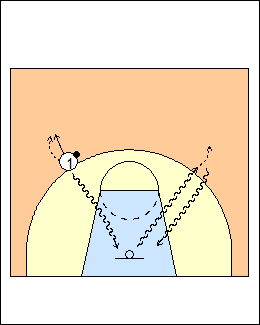Pasquali pivoting
 | 1 Renato Pasquali via Andy Sparks 1) Players spin a pass, jump stop, pivot 180 degrees ripping the ball overhead into triple threat, repeat for five times, then repeat five times sweeping the ball below the knees. Check the ball back into the triple-threat pocket as needed, e.g., ripping or sweeping from right to left for a right-hander. Progression - pivot then small jab step, pull it back, shot fake. |
 | 2 2) Facing away from the basket on the attacking right wing, spin a pass, catch and pivot on the left foot, jab step right, pull it back, make a direct-drive layup. Dribble out to the left wing, pass, catch, pivot on the left foot, jab step right, pull it back, make a crossover drive layup. See Footwork - Jay Wright jab-swing series. |
 | 3 3) Your pivot foot should be away from your defender. From the baseline, pass to coach and run for a handback, a) if coach holds the ball in his outside hand, forward pivot on the inside foot to rip the ball and attack baseline, shown for 1, left pivot foot (his defender would be high, taking away middle) b) if coach holds the ball in his inside hand, use the outside foot as the pivot foot to attack middle over top of coach, shown for 2, left pivot foot (his defender would be low, taking away baseline). Start with just the footwork, then progress to power layups, the release point should be away from the defender. Mike MacKay Depending on the how coach holds the ball the player takes the ball baseline or middle. The coach controls the move, mix it up. If coach holds the ball out to the side the player rips the ball and goes baseline. It is important to work on proper footwork to prevent traveling. A little skier hip turn puts the player in a strong athletic position before the dribble. If coach holds the ball behind him/her the offensive player curls, takes the ball for a middle dribble jump shot. Try to take the ball from the coach with the outside foot down. This allows for a stronger and tighter curl. If the inside foot is used the next step will lead to wide turn since it is with the outside foot. The power lay-up is a very important skill for players to learn who are driving into traffic. The footwork is the same as the regular lay-up starting with the outside foot followed quickly by the inside foot. The only difference is that the player does not continue to drive the outside foot up, he/she takes off on both feet. If trouble occurs the player can use the outside foot to pivot away. As they become more adept they can also develop a little baby hook from this position. If the defence moves up the player can step through by continuing to pivot. Throughout the whole process the player stays strong and on balance. Why the outside pivot foot? - It allows the players to carry a little more speed. A straight two foot jump stop requires a lot of strength to come to a complete balanced stop. - The player is stepping into the contact. If a bump occurs they can push into it. If the inside foot is used they often have to step back to gain their balance and power. This puts them in a weaker position. - They can KOB (keep on back) the defender by cutting him/her off on the second step. See 1 on 1 - Pasquali corner-wing cuts, Dave Malowski, Shooting - Pasquali reaction. |
This page was made with Basketball playbook from Jes-Soft